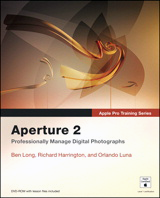
Aperture 2: Professionally Manage Digital Photographs
Authors: Ben Long, Richard Harrington, Orlando Luna
Company: Peachpit Press (Apple Pro Training Series)
ISBN: 978-0-321-53993-9, 486 pages plus DVD
Price: $54.99
Aperture 2 is the top of the line photo management and editing software from Apple. When Apple released Aperture 1.0 in 2005, it was a revolution, to say the least. We were used to having a photo classification method, be iPhoto, Adobe Bridge, or a directory structure, and a separate photo editor such as Photoshop. Aperture appeared to replace all of that, by combining both a photo management tool and a photo editor in the same application.
Version 1.0 was far from perfect, but with Aperture 2.x, Apple added many of the required features to make it a real pro-application for both tasks. Those pro features also mean that the software has more power and is more complex to use. Hence the need for a book to get you up and running in no time. That is where Aperture 2: Professionally Manage Digital Photographs can come-in handy.
The structure of the book is divided in tree major sections: “Importing and Organizing,” “Image Editing,” and “Printing and Publishing.” The first section has tree chapters that help you get started importing your pictures and getting organized. The second section goes through all the editing tools included in the software. The last section helps you use Aperture’s features to publish your images and present them to your customers. The book ends with two appendices that help you with more complex tasks, such as using references files, and how you can integrate iPhoto into your workflow with Aperture.
This book is structured like a course. Chapters are presented as lessons on a specific set of subjects. The first page of each lesson will tell you what you’re expecting to learn by the end of the lesson. What is really nice about the instruction is the fact that the authors are telling you how much time you should expect to spend for each of them. For example, Lesson One is evaluated at 60 minutes, while Lesson Two is suppose to take you 120 minutes, and Lesson Three has a whooping 180 minutes. This could help you, as a student, plan your learning agenda.
The book is accompanied by a DVD that includes all the material that is used in the text. So, in each lesson, you can follow the authors’ instructions using the same images they used to write the book. That will, for sure, help you better understand what the authors are trying to teach you.
There is nothing more frustrating than trying to follow a set of instructions when you do not have the same content to work with. For example, in photo editing, when the authors tell you to use a specific tool until you get a specific result, with the same image you should easily understand how the tool works. In the long run, you do not want to know how to correct the authors’ images, but to understand Aperture’s tools so you eventually edit your own pictures.
Aperture 2: Professionally Manage Digital Photographs goes into every little things that Aperture can do for you. While you can easily see and use the sliders in the interface, it is not obvious by looking at them that using a modifier key will improve the tools’ functionality. They are also describing features like round-tripping to an external editor, such as Photoshop. And if your camera RAW file format is not yet recognized by Aperture, did you know you can use a free DNG converter from Adobe to be able to edit it in Aperture without having to wait for Apple to update the software? I point this out, because historically speaking Adobe has been faster to implement RAW decodes for new cameras than Apple ever was.
The authors also make intensive use of the shortcuts build into Aperture. Using those key-equivalent actions will help you save lot of time in your photo editing and management. The mouse is a great tool, but when you get use to the keyboard shortcuts, the time you spend in your photo management and editing software can be shortened by a huge amount of time. Take it as more time to get out and do what you really want to do: shoot more pictures.
To conclude on this book, if you are new to Aperture, this is certainly a title you want to take a look at. It is imaged properly to help you follow the learning describe inside. If you already use Aperture, but do not feel you are up to speed with it, Aperture 2: Professionally Manage Digital Photographs will certainly help you get faster and better editing and management skills. This is a book to help you master Aperture like a pro, and receives our highest recommendation.
MyMac Review Rating: 10 out of 10
email – MyMac Magazine – Twitter – Advertise – Reviews Archive – Podcast

Leave a Reply
You must be logged in to post a comment.